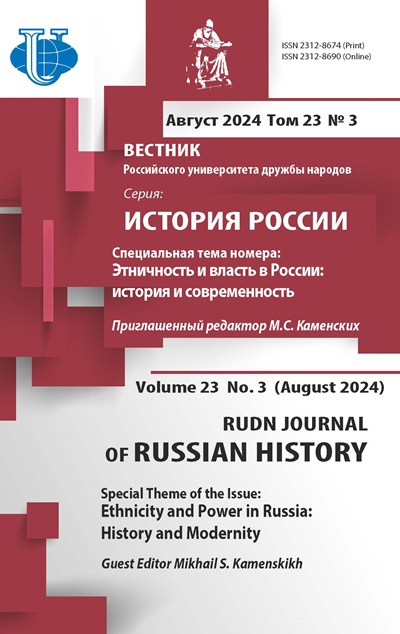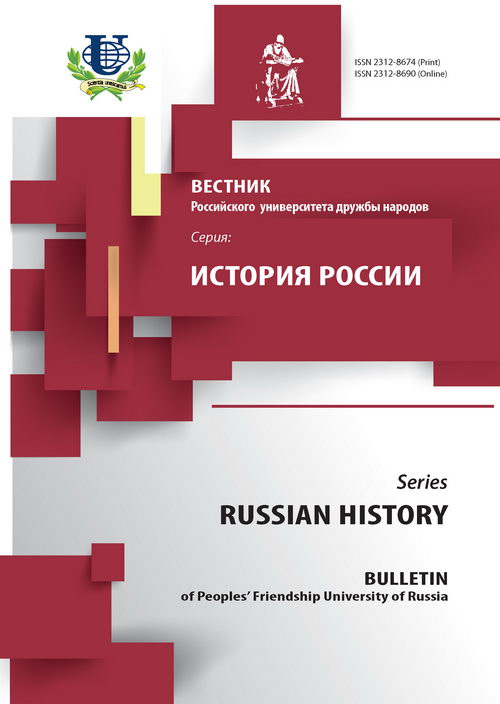Vol 15, No 2 (2016)
- Year: 2016
- Articles: 15
- URL: https://journals.rudn.ru/russian-history/issue/view/838
ARTICLES
SCHISM AND STATE POWER (THE CASE OF PRIISHIMYA)
Abstract
The article analyzes the peculiarities of the spread of one of the most mass religious movements within the Russian Orthodox Church - schism. On the basis of earlier unpublished archival documents, statistics and social and demographic population surveys of Priishimya of the pre-revolutionary time there are considered little-known facts reflecting the relationship between the state and the Old Believers both at the all-Russian and local level. The analysis allowed to identify three periods characterized by the transition from quite negative to tolerant attitude of the state authorities towards the Siberian Old Believers. Essential restrictions in the rights, material and spiritual culture led to such negative consequences as self-immolation, high death rate and isolation. The Liberal reforms of the early 20th century, the spread of atheism led to the rapprochement of the orthodox Christians and conservatives on the eve of the October revolution of 1917.
RUDN Journal of Russian History. 2016;15(2):7-18
 7-18
7-18


MAIN STAGES OF HISTORY OF “CULTURAL” POPULISM
Abstract
The article deals with the history of the conceptualization of "cultural" or "kulturnichesky" populism.In the literature it is the name of the right wing reformist populism. In the 80-90s of the nineteenth century the intelligentsia. The author focuses on the periodization of the history of "cultural" populism. Previously, researchers paid little attention to this issue. The ideology and practice of the later ideas of populists I.I. Kablitz, Y.V. Abramov, S.N. Krivenko had a great impact on the advanced Russian populists embodied the process of liberalization of populism, its reconciliation with the autocracy and emerging capitalism. The periodization proposed by the author includes four stages: the origin of “kulturnichesky” ideas (1869-1874), the development of the theory and practice of "kulturnichestvo" (1875-1884), the evolution of "cultural" populism (1885-1894) and finally, the ideological and organizational crisis of the cultural-populist trend (1895-1904). At the heart of the author's periodization is the idea of the progressive development of populist ideas: from “kulturnichesky” trend towards the theory of "small deeds " and then, under the influence of the general crisis of populism in the early 1890s, towards the development of the concept of broad "cultural work" (with social and political implications, which the theory of "small deeds" lacked). This approach seeks to emphasize the role of the cultural ideas in the evolution of populism in the 1880-1890s, in the turning of yesterday's rebels and revolutionary propagandists into a constructive social force. According to the author, its application to the history of the Russian populism may change the image of the populist in the modern scientific and educational literature.
RUDN Journal of Russian History. 2016;15(2):19-28
 19-28
19-28


THE NEWSPAPER "RUSSIAN BULLETIN" ABOUT THE ROLE OF THE ZEMSTVO IN THE MODERNIZATION OF POST-REFORM RUSSIA (1870 S.)
Abstract
This article analyzes the work of the newspaper "Russian bulletin". It was known in Russia as the organ of the liberal, non-partisan press in the mid-1870s. Newspaper united under the roof of the famous representatives of Russian liberal thought-economists and lawyers A.S. Posnikov, A.I. Chuprov, V.Y. Skalon. The purpose of the article - the study of the social and political situation of the newspaper and its role in the protection of liberal reformsin the first place - the protection of the zemstvo.The new qualitative stage in work of zemstvo was connected with development of statistics. Statistical researches allowed to solve more effectively local problems and highly lifted authority of zemstvo. For the 1870th the newspaper resolutely defended idea of democratization of zemstvo. Publicists of the newspaper considered that local authorities has to be released from under control of the nobility, serve interests of all groups. The newspaper considered means of democratization of local governments. "The Russian bulletin" resolutely supported association of zemstvo.The newspaper supported liberal tendencies of the government M.T. Loris-Melikov, also supported to him the address of "25 Moscow citizens". The program of the newspaper consisted in attractting to the solution of public problems of representatives of civil society.
RUDN Journal of Russian History. 2016;15(2):29-35
 29-35
29-35


POLES AND BELORUSSIANS UNDER WESTERN BELARUS INTEGRATION INTO THE SOVIET STATE
Abstract
The article deals with the problem of involving the Polish and Belorussian population in the integration processes on the territory of the Western Belarus in 1939-1941. The aim of the study is to identify the basic behavioral aspects inherent in the main ethnic communities of the region, as well as to create the retrospective reconstruction of the scheme of the relationship pattern between the new government and the local population, given its national, cultural and social characteristics. The research technique is based on the comparison of the memoirs and evidence from the archival materials that reflect the mood of the society, the key setting of the policy, as well as certain documents of the state and party administration, security bodies, analysis of the development of ethnic conflicts in the historical turning point. Due to the limited distribution of works of foreign researchers among the Russian audience a special emphasisis put on identifying the common ground in comparing the domestic (Soviet, Russian and Belorussian) and Polish historiography. The study determines the different nature of the contradictions between the Belorussian and Polish communities, demonstrates the methods of removing interethnic tension, identifies a number of ideologically and economically motivated actions committed by the Soviet administration aimed at the local population, that affected their attitude towards the new way of life, confirmed the successful experience of integration into the system of relations, adopted in the USSR. The results may be applicable in the analysis of ethnic conflicts in a historical perspective, as well as in the demonstration of the successful integration experience in the region during the changes of borders and political systems.
RUDN Journal of Russian History. 2016;15(2):36-44
 36-44
36-44


PROBLEM OF LEGAL STATUS SETTLEMENT OF REFUGEES AND DISPLACED PERSONS AFTER THE WORLD WAR II
Abstract
In the history of Russia "the second wave" of Russian emigration was a unique phenomenon in its origin and political destiny. The appearance of the camps for displaced persons was another milestone in the history of the Russian emigration. In this regard, the study of the daily life of displaced persons is particularly relevant. The complexity of this issue was realized immediately after the war, in Germany there accumulated huge masses of foreigners who came voluntarily or were forcibly brought. This article describes various aspects of the legal status of refugees and displaced persons on the basis of the Charter of the International Organization for Refugees and the Charter of the IRO, as well as other international legal instruments. In addition, the authorconsiders the activities of the emigre organization - "The Society of Russian foreign lawyers in Germany", associated with the problems of regulating the legal situation of refugees and displayced persons ("DP" - «Displaced persons»), as well as other legal issues, including repatriation and immigration.
RUDN Journal of Russian History. 2016;15(2):45-54
 45-54
45-54


TURKESTAN MUSLIMS’ “HOLY PLACES” AS CENTRES OF ANTIRUSSIAN ACTIVITIES OF TURKISH SECRET SERVICE (SECOND HALF OF 19TH - EARLY 20TH CENTURIES)
Abstract
The article deals with one of the aspects of the history of the Russian-Turkish relations in the period under consideration. The evidence suggests there was a high level of tension in the Russian-Turkish relations throughout its development. They often escalated into open military conflicts. The Russian penetration into Turkestan in the second half of the 19th century angered the Ottoman Empire’s ruling circles and forced them to send their agents to the Caspian region. Russia’s annexation of Central Asia by the 1860-1870s strengthened Turkey’s anti-Russian policy. As a result, the number of Turkish agents increased in Russian Turkestan. The Ottoman Empire’s intelligence service actively used the “holy places” of Islam in Turkestan as the centres of the largest concentration of Muslims of the region with the view of anti-Russian propaganda. Virtually all anti-Russian uprisings in the region began at the graves of Islamic "righteous." Despite serious countermeasures the tsarist authorities did not manage to eradicate the Turkish agents from the state and political life of the region and completely destroy all its subversive activities.
RUDN Journal of Russian History. 2016;15(2):55-65
 55-65
55-65


RUSSIA AND AFRICA AT THE TURN OF THE XX-XXI CENTURIES: RESULTS AND PROSPECTS OF COOPERATION
Abstract
The article reveals the state of modern Russia's relations with African countries, focuses on the importance and relevance of the Soviet experience in the region and willingness of African countries authorities to provide preferences to Moscow. It is noted that Africa at the turn of XX-XXI centuries is the subject of economic rivalry like between the former metropolitan countries and the new political factors like the US and China. In this regard Russia as the legal successor of the Soviet Union could use the potential accumulated during the Soviet period, taking into account the fact that the African states still maintain a positive image of the Soviet Union as a country that has made a decisive contribution to the liberation of the continent from colonialism. The author defines the prospects of further cooperation of Russia with the countries of Africa, especially in the economic, military and political spheres.
RUDN Journal of Russian History. 2016;15(2):66-72
 66-72
66-72


P. I. JURGENSON’S CREATIVE FORMATION AND ACTIVITIES
Abstract
On the example of the outstanding music publisher the article analyzes the brief history of the formation and activities of the music firm, which received an official status as a music publisher in 1861. It is fundamentally important to study the biographies of prominent personalities who have played a prominent role in the history of Russia. Among them is Pyotr Jurgenson, the Moscow music publisher who left an indelible mark both in Russia and far beyond its borders.The study of the world-famous personality of this music publisher is necessary for many reasons. The research allowed to substantiate the need for the development of serious musical education not only in Moscow and St.-Petersburg, but also in many regions of the Russian Empire that had a beneficial impact on the revitalization and quality of musical education of the masses and, above all, talented young people. The article shows that it is pressing to preserve P.I. Jurgenson’s rich musical heritage.The author emphasizes P.I. Jurgenson’s great role in the establishment and functioning of the musical-historical journal that played a great positive role in the history of the Russian music.
RUDN Journal of Russian History. 2016;15(2):73-81
 73-81
73-81


‘IN THE HEART OF A GREAT FOREIGH HOMELAND': BI-ROOTED MIND-SET IN THE POEMS OF RACHEL BLUWSTEIN AND LEAS GOLDBERG
Abstract
The biographical and poetic similarity between Rachel Bluwstein (1890-1931) and Lea Goldberg (1911-1970) calls for a comparative study of the two poetesses, which were undertaken in the specific context of migrant literature, in light of the term “bi-rootedness”. Both Bluwstein and Goldberg had “double roots”, in Russia and in the Land of Israel, and this can be clearly seen in a “bi-rooted” mind-set manifest in their poems, which will be examinedin this paper. In my analysis two manifestations of this “bi-rooted pain”will be observed: European memories and a yearning for the old homeland on the one hand, and the rejection of adapting to the new homeland on the other.
RUDN Journal of Russian History. 2016;15(2):82-92
 82-92
82-92


WESTERN DIRECTION OF RUSSIAN’S FOREIGN POLICY IN THE LATE 19TH CENTURY ACCORDING OF RUSSIAN LIBERALS’ MEMOIRS
RUDN Journal of Russian History. 2016;15(2):93-97
 93-97
93-97


FROM THE BIRTH HISTORY OF THE ENVIRONMENTAL MOVEMENT IN RUSSIA
RUDN Journal of Russian History. 2016;15(2):98-102
 98-102
98-102


FEATURES OF INFRASTRUCTURE MODERN METROPOLIS (ON THE EXAMPLE OF THE MOSCOW METRO)
RUDN Journal of Russian History. 2016;15(2):103-106
 103-106
103-106


SINO-RUSSIAN HUMANITARIAN COOPERATION
RUDN Journal of Russian History. 2016;15(2):107-111
 107-111
107-111


PRINCIPAL SCIENTIFIC WORKS OF THE LECTURERS OF THE DEPARTMENT OF RUSSIAN HISTORY OF PEOPLES’ FRIENDSHIP UNIVERSITY OF RUSSIA IN 2015
RUDN Journal of Russian History. 2016;15(2):112-116
 112-116
112-116


OUR AUTHORS
RUDN Journal of Russian History. 2016;15(2):117-119
 117-119
117-119
















